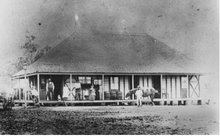Johannes Voight continues to hide some fascinating facts in writing that is both dry and verbose, if such a combination is possible. He uses a lot of very boring words to say some interesting things about German migration to Australia. In a measure of the dryness of his prose, it managed to put me to sleep in spite of a jackhammer, two drills and a dingo in the background. A dingo is not the famous animal that “got my baby!” but a small digger that is operated by standing on a platform in front of controls. This one is outfitted with a post-hole auger that is being used to dig the holes for the stumps of our house. They are very noisy especially when they operate right outside your window.
I found out today that Voight was a research fellow in history at my alma mater the year I was born. Perhaps this explains a few things, but I have read many fascinating historians writing in different eras and it is not as if he is writing about boring material. In Voight’s defense, I am still unwell so I may be unusually tired and less able to concentrate.
One of the things that annoys me about the book is that while facts are rigourously footnoted, illustrations are merely attributed to their sources without further details. A map of German settlements in Queensland from the Institute for Foreign Relations in Stuttgart is undated. Hand-drawn, it lists 35 settlements, twelve of which are in the Rosewood Scrub. The only other such cluster of settlement was around the Wide Bay (Maryborough, Gympie, Bundaberg) area. If you add in settlements near but not in the Rosewood Scrub like Ipswich Kalbar and Fassifern, 13 out of 35 listed settlements (37%) were in this area.
I’ve listed the settlements below. From the names, I’m guessing that the map was from around the era of the First World War as it lists the Anglicised names of some of the Rosewood Scrub towns as “new names.” For example, Minden reverted to its old name and Marburg’s name changes aren’t even noted (Marburg to Townshend and back to Marburg).
1. German Station (Nundah – according to Voight from the German phrase “Wir sind nun da” “We are here now.”
2. Waterford (Betania Junction)
3. Ipswich
4. Toowoomba
5. Rosewood
6. Fassifern
7. Beenleigh
8. Lockyer
9. Plainland
10. Hessenburg (Ingoldsby)
11. Maryborough
12. Bundaberg
13. Mackay
14. Laidlay
15. Hatton Vale
16. Marburg
17. Minden (Frenchton)
18. Engelsburg (Kalbar)
19. Bergen (Murra Murra)
20. Bergenside (Neuve)
21. Bismarck (Maclagan)
22. Gehrkevale (Mount Mort)
23. Gramzow (Carbrook)
24. Hapsburg (Kowbi)
25. Kirchheim (Haigslea)
26. Roessler (Applethorpe)
27. Stegeht (Woongoolba)
28. Teutoburg (Witta)
29. Zahley (Kilbirnie)
30. Baffle Creek
31. Binjour Plateau
32. Tarampa
33. Steiglitz
34. Kleinton
35. Prenslau.
Subscribe to:
Post Comments (Atom)

1 comment:
I've heard the same story about Nundah being named for "wir sind nun da" however the wiki page for nundah, details that this name is derived from an aboriginal tribe.
Post a Comment